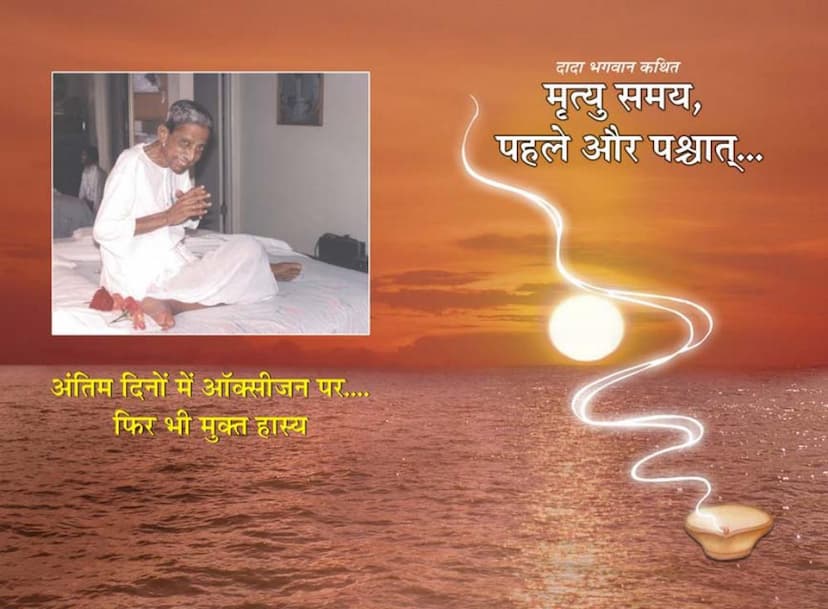Mrutyu Samaya Pahle Aur Pashchat
Added to library: September 2, 2025

Summary
Here's a comprehensive summary of the Jain text "Mrutyu Samaya Pahle Aur Pashchat" (Before and After the Time of Death) by Dada Bhagwan, based on the provided content:
Book Title: Mrutyu Samaya Pahle Aur Pashchat (Before and After the Time of Death) Author: Dada Bhagwan (Shri Ambalal M. Patel) Publisher: Mahavideh Foundation
This book, based on the profound spiritual discourse of Dada Bhagwan, aims to demystify the experience of death, offering clarity and solace to seekers. It addresses the fears and uncertainties surrounding mortality by explaining the actual processes involved before, during, and after the cessation of physical life.
Core Teachings and Themes:
- Understanding Death: The book asserts that death is not an end but a transition. It clarifies that the physical body perishes, but the soul (the Self) is eternal and unchanging. The fear of death stems from an identification with the perishable body and ego, rather than with the true Self.
- The Nature of the Soul: Dada Bhagwan emphasizes that the Soul (Atma) is pure, unborn, and immortal. It is the eternal witness, unblemished by birth or death. The cycle of birth and death is attributed to the ego (ahankar) and the mistaken identification with the physical form and its associated worldly entanglements.
- The "Akram" Path: The book is a product of Dada Bhagwan's "Akram Vignan" (a non-sequential, direct path to Self-realization). This path offers a shortcut to understanding the ultimate truths of life and death through the grace of a living Self-Realized Being (a Gnani Purush).
- The Process of Transition: The text delves into what happens before, during, and after death. It explains:
- Before Death: The final moments, the body's weakening, and the importance of maintaining a positive mental state, free from fear and regret.
- During Death: The soul's departure from the physical body. The book clarifies that there is no "Yamraj" (a deity of death) but rather "Niyamraj" (the law of nature). The hour of death is when accounts are settled.
- After Death: The soul's transition to another form of existence based on its accumulated karma and desires. It discusses various "gatis" (realms of existence) such as human, animal, heavenly, and hellish. The concept of subtle bodies (like the electrical body/Tejas Sharir) that accompany the soul is also explained.
- Karma and Reincarnation: The book extensively explains the law of karma. Actions (karma) create causes (karan) and effects (effect), leading to a continuous cycle of birth and death. The book clarifies that it is the "jiva" (the embodied soul) with its desires and ego that transmigrates, not the pure Soul itself.
- Dispelling Misconceptions: Dada Bhagwan addresses many popular beliefs and rituals associated with death, such as the significance of Shraddha, Teras (13th-day rituals), performing religious ceremonies for the deceased, and the concept of an "Ambasht" (thumb-sized soul). He reveals the scientific or practical origins behind some of these practices, while also dispelling superstitious interpretations.
- The Purpose of Human Life: The paramount importance of the human birth is highlighted. It is considered the only form of existence where one can attain Self-realization and break free from the cycle of birth and death by meeting a Gnani Purush.
- Dealing with Grief and Loss: The book offers guidance on how to behave when a loved one passes away, emphasizing the importance of maintaining equanimity and performing actions that are beneficial for the departed soul, such as prayers and good intentions. It also addresses the ego-driven nature of personal grief.
- Suicide: A significant portion of the book discusses suicide, explaining its dire consequences—leading to the formation of a "pret" (ghost) and a difficult journey of suffering through many subsequent births. It strongly discourages suicide and offers an alternative: seeking help from a Gnani Purush.
- The Nature of Fear: The fear of death is identified as a fear of the ego, not of the Soul. With the realization of the true Self, this fear naturally dissolves.
- The Importance of Living with Awareness: The text encourages living each moment with awareness and detachment from worldly possessions and relationships, as nothing truly belongs to us when we depart.
- The Ultimate Goal: Moksha: The ultimate solution to the cycle of birth and death is Moksha (liberation), which is achieved through Self-realization. This book is presented as a guide to understanding the path to achieve this ultimate freedom.
Key Concepts Explained:
- Akram Vignan: A direct and non-sequential path to Self-realization.
- Gnani Purush: A Self-Realized Being who can transmit Self-knowledge.
- Atma: The Soul, the eternal, pure, and unchanging Self.
- Ahankar: The ego, the false identification that causes suffering and the cycle of rebirth.
- Karma: The law of cause and effect that governs the cycle of birth and death.
- Gati: Realms of existence (human, animal, heaven, hell).
- Sukshma Sharir (Subtle Body) & Karan Sharir (Causal Body): The non-physical components that accompany the soul after death.
- Pratikraman: The practice of asking for forgiveness for past mistakes, crucial for clearing karma.
- Samadhi Maran: Dying with full awareness of the Self, in a state of equanimity.
In essence, "Mrutyu Samaya Pahle Aur Pashchat" provides a rational, scientific, and spiritually profound explanation of death according to Dada Bhagwan's teachings. It aims to empower readers with the knowledge to overcome the fear of death and to live a life dedicated to realizing their true, eternal nature.